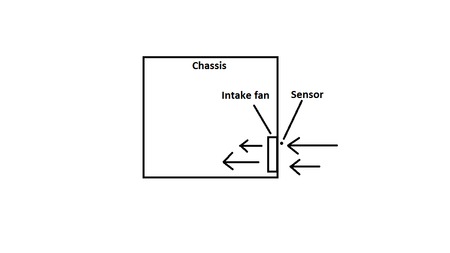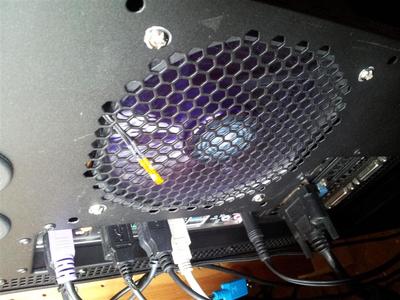 18.04.2024, 18:33
18.04.2024, 18:33 Sprache ändern
Sprache ändern
 Registrieren
Registrieren Anmelden
Anmelden
Sie sind nicht angemeldet.
Lieber Besucher, herzlich willkommen bei: Aqua Computer Forum. Falls dies Ihr erster Besuch auf dieser Seite ist, lesen Sie sich bitte die Hilfe durch. Dort wird Ihnen die Bedienung dieser Seite näher erläutert. Darüber hinaus sollten Sie sich registrieren, um alle Funktionen dieser Seite nutzen zu können. Benutzen Sie das Registrierungsformular, um sich zu registrieren oder informieren Sie sich ausführlich über den Registrierungsvorgang. Falls Sie sich bereits zu einem früheren Zeitpunkt registriert haben, können Sie sich hier anmelden.
Hi I'm new here, I just got my Aquaero 5 Pro in the mail and I have a couple questions about it.
I've never used temp sensors before so I'm not sure where to place them and how to attach them. I have a fully water cooled PC with the mother board, ram, cpu and two gpu's water cooled... I ordered 2 of the inline water temp sensors and was thinking of placing them on the inlet and outlet of the radiator. I was thinking of using the 4 temp sensors that came with the aquaero to measure ambient air temperature in the room and also other areas in my case, my question is... how do you install the temp sensors to measure ambient air? Do I just leave one hanging on the outside of my case or do I tape it to the outside of my case? If you tape it down, do you have to use a special kind of tape?
I want to set up a water temp - ambient air control to have the system keep the water temp close to the ambient air temp and I want to make sure I get a proper reading for the ambient air temp. Can you please explain how I should install the temp sensor or even better, post a picture of one of yours installed?
Thanks for the help,
Goetz
I've never used temp sensors before so I'm not sure where to place them and how to attach them. I have a fully water cooled PC with the mother board, ram, cpu and two gpu's water cooled... I ordered 2 of the inline water temp sensors and was thinking of placing them on the inlet and outlet of the radiator. I was thinking of using the 4 temp sensors that came with the aquaero to measure ambient air temperature in the room and also other areas in my case, my question is... how do you install the temp sensors to measure ambient air? Do I just leave one hanging on the outside of my case or do I tape it to the outside of my case? If you tape it down, do you have to use a special kind of tape?
I want to set up a water temp - ambient air control to have the system keep the water temp close to the ambient air temp and I want to make sure I get a proper reading for the ambient air temp. Can you please explain how I should install the temp sensor or even better, post a picture of one of yours installed?
Thanks for the help,
Goetz
Thanks for the info and pictures gullars,
I have a Corsair 800D case with a RX360 rad and three fans blowing air through the rad out of the case, my back fan is also blowing air out and I have a fan in the mid section of the case blowing air up from the bottom. Should I put the sensor out the bottom of the case or I was thinking of placing it along the back panel of the case behind the mother board and straight out the back to the left of the I/O plate?
I guess I could also change my back fan to an intake and place it there, what do you think would work best?
I have a Corsair 800D case with a RX360 rad and three fans blowing air through the rad out of the case, my back fan is also blowing air out and I have a fan in the mid section of the case blowing air up from the bottom. Should I put the sensor out the bottom of the case or I was thinking of placing it along the back panel of the case behind the mother board and straight out the back to the left of the I/O plate?
I guess I could also change my back fan to an intake and place it there, what do you think would work best?
Hi Goetz,
I also have the 800D and i placed my ambient (outside air) temperature sensor on the bottom. If you are using the default fan configuration, this is where your intake air is coming from.
There is a small hole at the bottom, through which you can thread the sensor.
Something like this:

The sensor that measures the temperature on the inside of the case is just floating freely near the middle of the case.
Kind regards,
Boris.
I also have the 800D and i placed my ambient (outside air) temperature sensor on the bottom. If you are using the default fan configuration, this is where your intake air is coming from.
There is a small hole at the bottom, through which you can thread the sensor.
Something like this:

The sensor that measures the temperature on the inside of the case is just floating freely near the middle of the case.
Kind regards,
Boris.
I've read a ton of forums and it's about a 50/50 split as to have the radiator fans as an intake or exhaust. Do you think that the air inside my case is much warmer then the outside air with everything water cooled Namron? I'm not sure what way to go now, if I do it as an intake, I'll be blowing warm air over my motherboard and video cards but my radiator may cool a little better. I like to have a quite system and low RPM's on the fans, does that make any difference as to which way I should set it up?
Thanks for the picture Boris, I like the idea of hiding the temp sensor under the case.
Thanks for the picture Boris, I like the idea of hiding the temp sensor under the case.
Hi Goetz,
I went through a huge number of posts while deciding how to construct my loop and how to place the fans inside the case. As you say, opinions are divided.
In my case, with a water cooled CPU and GPU, there is around a 5 C difference between the ambient and the case temperature. This is with the fans at minimum RPM (almost inaudible) and with a standard 800D fan arrangement. I think that by using the radiator fans as intake you are fighting the natural heat convection. One change that I liked is changing the back exhaust fan to intake, but I did not bother with it and I plan on adding a 120 radiator there in the future anyway.
You do have quite a demanding loop, maybe you should consider modding the case to fit a 480 radiator at the top, or a 240 one at the bottom.
Kind regards,
Boris.
I went through a huge number of posts while deciding how to construct my loop and how to place the fans inside the case. As you say, opinions are divided.
In my case, with a water cooled CPU and GPU, there is around a 5 C difference between the ambient and the case temperature. This is with the fans at minimum RPM (almost inaudible) and with a standard 800D fan arrangement. I think that by using the radiator fans as intake you are fighting the natural heat convection. One change that I liked is changing the back exhaust fan to intake, but I did not bother with it and I plan on adding a 120 radiator there in the future anyway.
You do have quite a demanding loop, maybe you should consider modding the case to fit a 480 radiator at the top, or a 240 one at the bottom.
Kind regards,
Boris.
I knew I was coming in on a fairly contentious subject  & I can only speak from personal experience for my particular systems set-ups e.t.c. I have run my 800D twin loop set-up for nearly three years now with many different rads/fans set-ups & taking pretty precise temp/noise & dust measurements e.t.c..
& I can only speak from personal experience for my particular systems set-ups e.t.c. I have run my 800D twin loop set-up for nearly three years now with many different rads/fans set-ups & taking pretty precise temp/noise & dust measurements e.t.c..
For me it has always been the case that, I get lower temps alround by drawing the cooler room air through the radiators into the case, be that using single set of fans or in push/pull, I only have one fan on rear of the case a 140 as an exhaust fan with all other fans (which is 7 x 120's) pulling air into case, 6 x 120 fans in push/pull in top of case, 1 x 120 in bottom, so I have only one 140 as an exhaust fan, This in turn gives you a possitive air preasure inside the case which in turn helps to keep dust from getting into the case (A possitive inside case air preasure DOES help to keep the dust down more so than a negative inside air preasure) As I have said I can only speak as I have found for myself by trial & error using many different componants & overclocking over the years & on my set-ups, I've never had any issues with high temps inside of the case doing it this way, Oh & yes I do use dust filters on all my intake fans
All the best & good luck
Norman
 & I can only speak from personal experience for my particular systems set-ups e.t.c. I have run my 800D twin loop set-up for nearly three years now with many different rads/fans set-ups & taking pretty precise temp/noise & dust measurements e.t.c..
& I can only speak from personal experience for my particular systems set-ups e.t.c. I have run my 800D twin loop set-up for nearly three years now with many different rads/fans set-ups & taking pretty precise temp/noise & dust measurements e.t.c..For me it has always been the case that, I get lower temps alround by drawing the cooler room air through the radiators into the case, be that using single set of fans or in push/pull, I only have one fan on rear of the case a 140 as an exhaust fan with all other fans (which is 7 x 120's) pulling air into case, 6 x 120 fans in push/pull in top of case, 1 x 120 in bottom, so I have only one 140 as an exhaust fan, This in turn gives you a possitive air preasure inside the case which in turn helps to keep dust from getting into the case (A possitive inside case air preasure DOES help to keep the dust down more so than a negative inside air preasure) As I have said I can only speak as I have found for myself by trial & error using many different componants & overclocking over the years & on my set-ups, I've never had any issues with high temps inside of the case doing it this way, Oh & yes I do use dust filters on all my intake fans

All the best & good luck

Norman
Hi Namron,
Thank you for sharing your experiences. Maybe I'll try it your way on my next re-build. There are certainly advantages of pulling outside air over the radiator.
Right now I am quite happy with the current loop and the cooling it provides, and with little modification 800D can be a very capable case for water cooling. At least until I go completely crazy and make a jump to something from Caselabs.
Kind regards,
Boris.
Thank you for sharing your experiences. Maybe I'll try it your way on my next re-build. There are certainly advantages of pulling outside air over the radiator.
Right now I am quite happy with the current loop and the cooling it provides, and with little modification 800D can be a very capable case for water cooling. At least until I go completely crazy and make a jump to something from Caselabs.

Kind regards,
Boris.
Thanks for the info Namron, I'll be redoing my loop in my computer to fit the AC 5 water block and will give it a try.
With your setup, where do you measure the ambient room temp? Is it better to put a sensor on the bottom, top or back of the case?
Also what kind of dust covers do you use?
Goetz
On my 800D system I have just the one sensor which is taped to the wall next to the case as below....
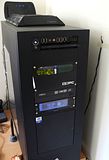
Sorry about the quality of the pics, Just grabbed a camera quick to show you what I mean
 ..
..For my test rig (which I'm just putting together in a new case, I have two sensors, One on top intake of the case & one in the front intake (I also have sensors placed inside the case & two sensors placed on the Pump) I don't have the dust filters fitted to this yet as I'm waiting for some to arrive, but here's a quick pic or two..
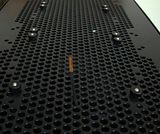

For dust filters I use just bog standard ones that are cheap & do the job just great for me... But there are many many options on the market..One of which is as our Boris has linked too below
 ..
..This is the ones I have on my 800D at the moment...
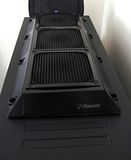

http://specialtech.co.uk/spshop/customer…-pid-12014.html
As I said sorry about some of picture quality, but hope it helps or gives you some idea's to go along with
 ..
..By the way, You'll Love the Aquaero 5...It's an awesome bit off kit (I have two of them the XT & a Pro) & did a very basic guide a while back when it first came out on setting it up & installing the waterblock e.t.c. Things have gotten alot easier with it now & new things are been added pretty much with each firmware update that AC come out with
 ..
..All the best & Enjoy
 .
.N.
Thanks Namron for the ideas. I finally have everything set up, I tried putting the fans on the top of my 800d and I got about a 1 - 2 degrees cooler temps but I couldn't handle the noise! With the fans up against the cases metal mesh on the top, the noise from the air pulling through is too much. I might get some fan shrouds / silencers and try it again.
I put the aquaero in the top 5.25 bay and there is no way to get the temperature sensor to reach the bottom of the case, I did get one to just reach out the back. Is there any longer temperature sensors that you can buy?
I put the aquaero in the top 5.25 bay and there is no way to get the temperature sensor to reach the bottom of the case, I did get one to just reach out the back. Is there any longer temperature sensors that you can buy?
Dieser Beitrag wurde bereits 1 mal editiert, zuletzt von »Goetz« (27. Juli 2012, 07:27)
All I've ever done when I'm connecting up several temp sensors is too first group them together (in a fan type shape) then take readings of all the readings....In an ideal world these readings would all be the same & for the most part
this has been the case for me, even on the ones I've extended, Bare inmind though that I've not extentended them any more than 30 or 40cm so don't know about longer runs...
If any of my sensors are reading a little low from what the other majority are, I just adjust the difference in the Aquaero off-set settings (but do keep an eye on that particular sensor just in case it's on the way out e.t.c)
All the best
N.
this has been the case for me, even on the ones I've extended, Bare inmind though that I've not extentended them any more than 30 or 40cm so don't know about longer runs...
If any of my sensors are reading a little low from what the other majority are, I just adjust the difference in the Aquaero off-set settings (but do keep an eye on that particular sensor just in case it's on the way out e.t.c)
All the best
N.
Dieser Beitrag wurde bereits 1 mal editiert, zuletzt von »Namron« (27. Juli 2012, 13:37)
Ähnliche Themen
-
 English forum »
English forum »-
 Connections For Temperature Sensor
(5. Dezember 2009, 21:56)
Connections For Temperature Sensor
(5. Dezember 2009, 21:56)
-
 English forum »
English forum »-
 Temperature sensor: Product Code 53067
(13. August 2009, 21:55)
Temperature sensor: Product Code 53067
(13. August 2009, 21:55)
-
 English forum »
English forum »-
 Temps
(21. August 2006, 15:20)
Temps
(21. August 2006, 15:20)
-
 Wasserkühlung »
Wasserkühlung »-
 Temp Sensor Aquaero im Aquatube
(19. Oktober 2004, 15:46)
Temp Sensor Aquaero im Aquatube
(19. Oktober 2004, 15:46)
-
 Wasserkühlung »
Wasserkühlung »-
 max Temp ?
(20. Dezember 2002, 21:06)
max Temp ?
(20. Dezember 2002, 21:06)
-


